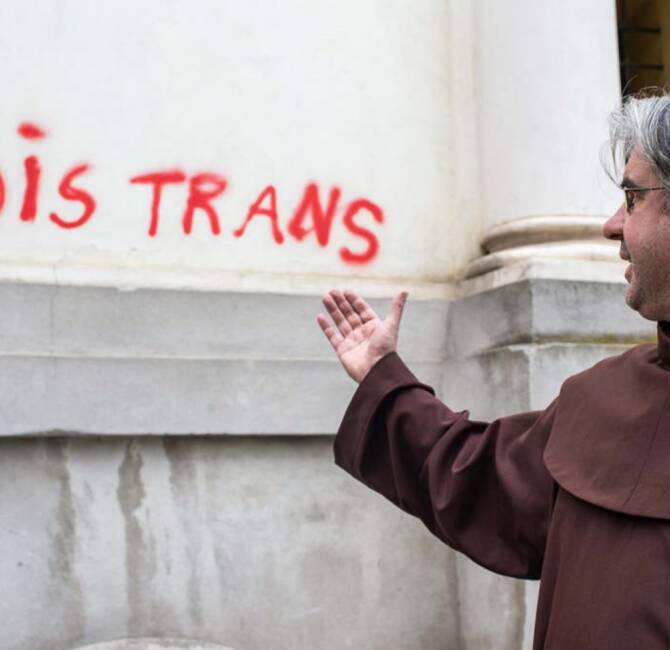The twists and turns along Jobbik’s road to “redemption” and Gyurcsány’s list
“Never say never”, as the adage goes. Few people realize the wisdom of the old cliché. The post-communist and liberal parties in Hungary certainly didn’t, nor did Jobbik itself in the last few years. They’ve spent so much time, spilt so much ink over grandiosely and earnestly rejecting each other in terms civil and obscene that it is with a sense of exquisite irony that we are witnessing their loving political embrace now. Of course, little could they imagine in the golden age of mutual hate and bile that one day, after a short but intense courtship and mating ritual, they would end up getting married. In light of recent developments, the original bickering among the Hungarian opposition could even be viewed as the political equivalent of domestic violence.
Roots
Given how much time they spent calling each other “Commies”, “Nazis” and “Jews”, it took quite spectacularly little for them to forgive each other and become one in unholy matrimony. In order to understand all the twists and turns along the road, we will have to take a short journey back in time. Jobbik came to this world in 1999, as a Right-wing youth movement and was officially established as a political party in 2003. After a failed election campaign in 2006, when they ran on a joint list with the ultraconservative MIÉP, the new chairman of Jobbik, Gábor Vona took the party down a decidedly radical path howling anti-Semitic and anti-Gypsy invectives. This communication strategy coupled with their (seemingly) irreconcilable antagonism towards the governing socialists and liberals propelled them first to the European Parliament in 2009 and then to the Hungarian National Assembly in 2010. At the time they would have denied Ferenc Gyurcsány the right to exist, and according to their founding charter, which is still proudly displayed on their website: “Our primary goal is to remove the post-Communist party from power along with the extremist liberals that attached themselves to it.”
The rising popularity of Jobbik and particularly the “patrols” of the Hungarian Guard, Jobbik’s paramilitary wing, and their electoral success in the 2009 elections for the European Parliament caused consternation on the Left-liberal side. Naturally, at the time (and this speaks volumes of the duplicity of the Left) their narrative claimed that the emergence of Jobbik was somehow Fidesz’s fault despite the latter being in opposition at the time. The way they framed the issue was that Fidesz was “the wolf in sheep’s clothing”, Jobbik was “their creature” so that they would say all the things Fidesz wanted to say, but didn’t dare. This was a time when the leftist think tank financed by George Soros, Political Capital devised an index (Derex) “to measure” extreme Right tendencies, Ferenc Gyurcsány thundered that “There is this, Nazi, anti-Semitic party and we are pretending as if this was tolerable within the Hungarian constitutional framework!” Gordon Bajnai called on all parliamentary parties to “reflect deeply on their own responsibility” in allowing this monstrosity to rise.
Beautifying the Monster
Indeed, as he was leaving the office of Prime Minister following the 2010 general elections that booted the parties behind his government out of power and delivered Jobbik its greatest success to date: they entered parliament as the third largest party, Gordon Bajnai called Gábor Vona’s party (whose current chairman, Péter Jakab was already a member at the time) a “monstrosity”, and called on Fidesz and MSZP to work together to defeat the common enemy. And something like that began to take shape not long after. Jobbik, and organizations attached to it, were always known for their vicious anti-Semitism on the streets, but it nevertheless came as a shock when on November 26 th 2012, Márton Gyöngyösi, then second-in-command of the Jobbik parliamentary group (now he is an MEP and the party’s vice-chairman) stood in the National Assembly to demand that a list be made of “the people of Jewish origin in the government and the parliament of Hungary who represent a national security risk”.
Although Gyöngyösi had already made and would go on to make a number of outrageous statements that could only be described as theatrically neo-Nazi in nature (on one occasion he referred to the Holocaust as “a strange beast”, on another he claimed that “Hungarian Jewry sided with Zionism against the Hungarian national cause”), his remarks calling for a list of Jews delivered in the National Assembly served to create an unprecedented consensus among all other parliamentary parties. Suddenly, there was universal rejection of the radical party, and a mass demonstration held a week after Gyöngyösi’s speech was supported by all parties (other than Jobbik, of course) and the entire Hungarian media, including leading leftist publications and intellectuals. The socialist dailies called for countering the neo-Nazi threat on their front pages. Ferenc Gyurcsány called Gyöngyösi “an object lesson in human scum becoming animal”. Attila Mesterházy (then chairman of MSZP) said “Fascism is a virus and Jobbik is the host”. Csaba Molnár from Gyurcsány’s Democratic Coalition (DK) went on a tirade repeatedly calling Jobbik and its politician “Nazis”, “Fascists” and the “spawns of the Arrow Cross Party”. Molnár, but also MSZP, didn’t stop at demanding a complete media blackout and parliamentary boycott, they demanded that Jobbik be legally banned.
This was perhaps Jobbik’s darkest hour, and it pushed the party to take the decision to start on a new political journey, now down the long and bumpy road towards the middle. In an attempt to touch up their image, Gábor Vona and other politicians from Jobbik started appearing next to young people, kittens and puppies. Their 2014 general election campaign was conducted in a fancy and trendy spirit. This foreshadowed the more substantive drift towards “becoming a modern people’s party” that would follow later, but at this point nothing prevented Péter Jakab from saying that “Jewish leaders deliberately generate those stereotypes, which in turn they refer to whenever they feel the need to ask for the creation of expansive programs to tackle anti-Semitism”. In the election, they received more than 20% of the vote, which didn’t put them in government, but could be argued to be a good result, as on the opposition’s side they came second only to the alliance of leftist and liberal parties that passed for “opposition unity” at the time. Back in 2014 they were not quite as infatuated with each other as now. By then, Vona, still chairman, was determined to push “Nazi romanticism” out of the party but had no love lost for the Left either (“Liberal junkies spend their time worrying about whales between two highs” he quipped.) And Gyöngyösi still dreamt of putting an end to “Israeli, Zionist terror”. Politicians on the Left were not shy about their feelings of repulsion towards Jobbik either. Ágnes Vadai, after some compulsory finger-pointing at Fidesz, declared with a voice bursting with pride that “we don’t need the votes of Nazis!” (except, now it seems they do). “Celebrated intellectuals on the Left” recorded video messages urging people to “Vote against Jobbik!”. With hindsight, perhaps the most amusing performance was delivered by one of the champions of today’s “United Opposition”, Gergely Karácsony, who, looking accusingly at Fidesz, was near tears as he declared that “The problem is not that there are confused people who march up and down, but that there is no clear differentiation between the modern center-Right and them. This lack of principles is what I find most disgusting about Hungarian politics.” Well, if it seemed disgusting then, unprincipledness today seems to be the very glue that holds together the opposition movement. While Jobbik seems to be following along some twisted political calculations, the Left-liberal parties have debased “the fight against fascism” to the point where it has become nothing more than a cheap bumper sticker to be solely used against conservatives.
Embracing the Inactive Nazis
Naturally, why Vona decided to drag his radical party towards the middle (which is equivalent to a leftward drift in any Western political system), why he couldn’t wait for the time when Fidesz would need a coalition partner for government and why he “stole the soul of Jobbik” is unclear to this day and theories abound, but one thing became clear very soon: the process was unstoppable. After the surprise victory in Hódmezővásárhely of the nominally independent Péter Márki-Zay who was a de-facto unity candidate supported by all opposition parties in 2018, the idea of creating a common electoral list, for that year’s general elections was seriously contemplated as was the notion of nation- wide coordination as a bare minimum form of political cooperation between all the opposition parties. At the time, MSZP and DK formed the most significant roadblock on the way to embracing Jobbik. “We cannot forfeit our status as modern European parties in exchange for a few votes” Gyurcsány lamented in February. Ágnes Kunhalmi reiterated that “Jobbik is part of the problem, not the solution”. To be sure Gergely Karácsony’s realization at the time that “there are still Nazis in Jobbik, but they are currently inactive, because they were forbidden to demonstrate their Nazism” did not facilitate the same cooperation in 2018 that has become a dream come true for the Left today. In 2019, when Karácsony was asked about Gyöngyösi’s list of Jews, he found no indications of Nazism in the idea.
In the end, there was no united electoral list in 2018 and the electorate delivered a resounding victory for Fidesz and a crushing blow to the opposition parties. Gábor Vona resigned and was replaced by Tamás Sneider, known as ‘Roy’ among the skinheads of Eger. The first six months of his tenure brought shocking “success”: by the end of the year Jobbik was demonstrating together with the other opposition parties against amendments to the Labour Code. This was probably the first occasion when the audience could witness politicians from Jobbik, MSZP and DK sharing a stage. After a failed election for the European Parliament and the partial success of the coordinated campaign in the local elections in 2019, the “masterpiece” that was started by Vona and chiseled by Sneider was finally completed by the current Jobbik chairman, Péter Jakab, as he formally signed his party over to the rainbow coalition. The icing on the cake must have been his photo op with Gyurcsány. The former First Secretary of the Hungarian Young Communist League, oligarch and failed prime minister, who was always a cornerstone of Jobbik’s identity – as evil incarnate to be defeated at all cost, has all but become a part of Jobbik. Or is it Jobbik that has become a part of Gyurcsány? In the end it doesn’t matter. They used to call each other monsters and now have become one. The far-Left and the far-Right have once again found each other, like Joachim von Ribbentrop finding his way to Vyacheslav Molotov. Or the way Arrow Cross Party members discovered for themselves the employment opportunities the communist secret police had to offer. Nothing good ever comes of this.





